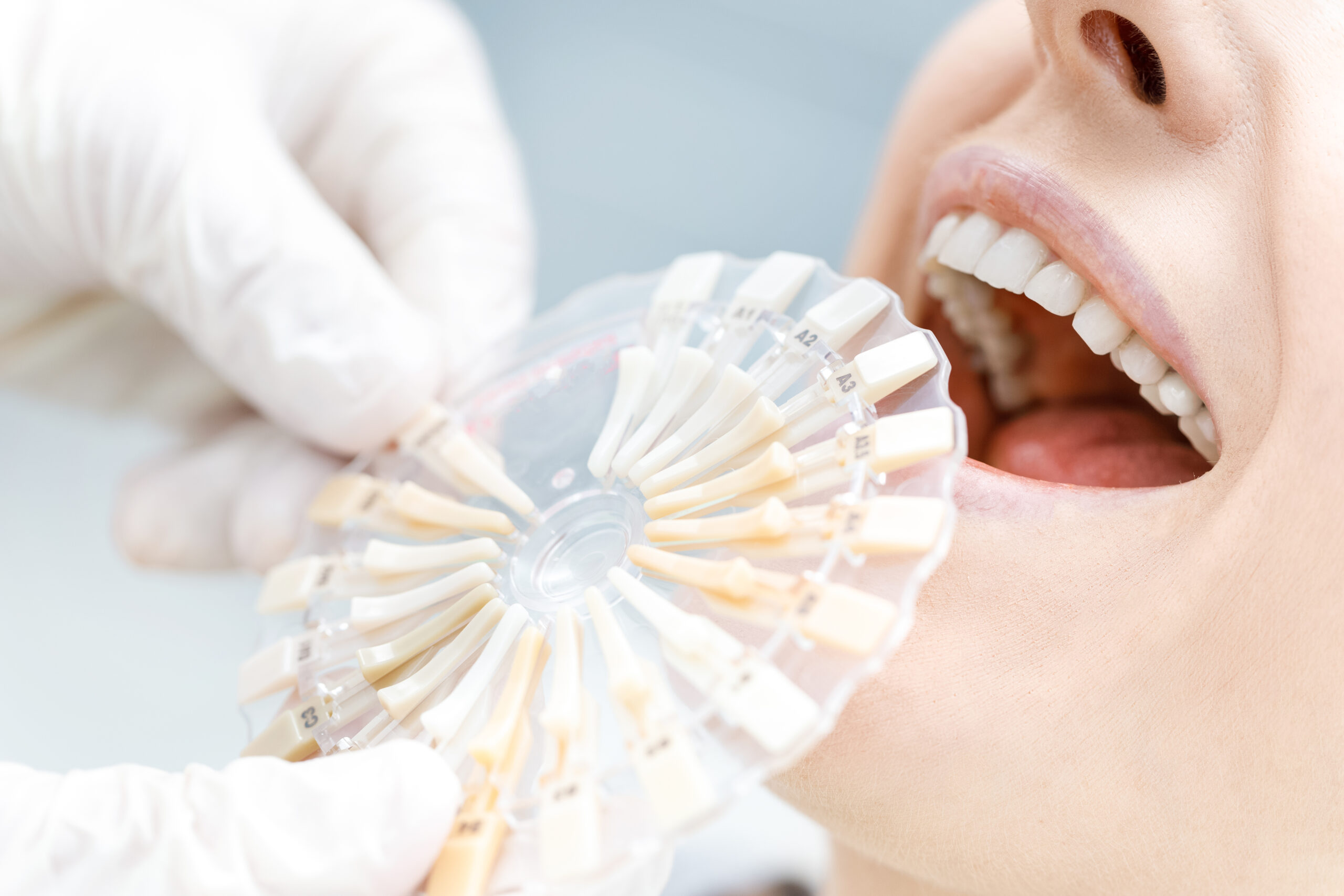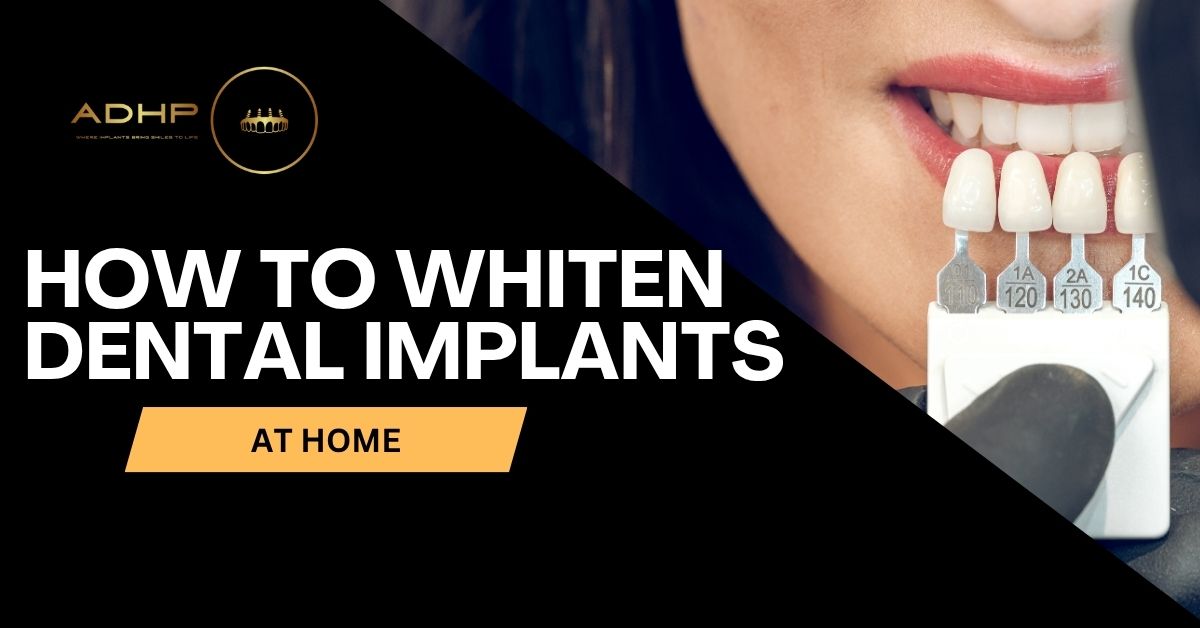Main Takeaways:
- Dental implants do not whiten like natural teeth because porcelain and ceramic do not absorb bleaching agents.
- Surface stains can appear from food, drinks, plaque, or differences in whitening between teeth and implants.
- Gentle brushing, flossing, and alcohol-free mouthwash help maintain implant brightness.
- Avoid harsh home remedies such as bleach, baking soda, or acidic rinses that can damage implant surfaces.
- Professional polishing or crown replacement may be needed to restore or match implant color.
- Limiting coffee, wine, and tobacco helps prevent surface discoloration.
- Regular dental checkups keep implants clean, functional, and consistent with your natural teeth.
Dental implants are a reliable way to restore a smile, but over time, patients often notice that their natural teeth and implants do not age in the same way. Unlike natural enamel, implants are made of materials like porcelain or ceramic, which respond differently to whitening treatments. This difference raises a common question many patients ask: how to whiten dental implants at home?
We’ll explore the realities of whitening implants, the limitations of home treatments, and the safest ways to keep your entire smile looking bright. We’ll also cover when professional care is needed and how specialists like ADHP Torrance can help.
Why Dental Implants Don’t Whiten Like Natural Teeth
To understand why implants behave differently, it helps to know what they are made of. Dental crowns on implants are often crafted from porcelain or ceramic fused to metal. These materials are strong and stain-resistant, but they don’t have pores like enamel.
Natural teeth stain when pigments from coffee, wine, tobacco, or certain foods seep into the tiny pores of enamel. Whitening agents, such as hydrogen peroxide or carbamide peroxide, penetrate enamel to break down those stains. Implants, on the other hand, have no pores, so whitening products cannot change their color.
This means that while whitening toothpaste or over-the-counter strips may brighten your natural teeth, your implants will remain the same shade they were on the day they were placed.
Common Causes of Implant Discoloration
Although the implant crown itself does not stain internally, discoloration can still occur. Here are some reasons why:
- Surface staining: Food and drinks can leave residue on the smooth surface of the crown.
- Plaque and tartar buildup: Poor oral hygiene may allow deposits to accumulate, dulling the implant’s shine.
- Wear and tear: Over the years, small scratches on the porcelain can trap pigments.
- Mismatched whitening: If you whiten your natural teeth but not your implant, the difference in shade becomes more noticeable.
Understanding these causes helps guide the best approach to keeping implants bright.
Safe At-Home Methods for Maintaining Implant Brightness
Since traditional whitening products won’t work on implants, patients often turn to home care strategies. While these won’t permanently change the crown’s color, they can help maintain a clean, polished look:
1. Daily Brushing and Flossing
Brushing at least twice a day with a non-abrasive toothpaste is essential. Avoid whitening pastes with harsh grit, as they can scratch porcelain surfaces and make them more prone to staining. Flossing around the implant also removes plaque that can dull its appearance.
2. Use of Soft-Bristled Toothbrushes
A soft-bristled brush prevents micro-scratches that trap pigments. Electric toothbrushes, when used gently, can also be effective in removing surface stains.
3. Alcohol-Free Mouthwash
Some mouthwashes contain alcohol that may weaken bonding materials around the implant. Opting for alcohol-free rinses can help preserve implant integrity while keeping your mouth fresh.
4. Professional-Grade Polishing Tools at Home
Special implant-safe polishing kits are available for purchase, though they must be used carefully. These kits help buff away surface stains without damaging the crown material.
While these methods help maintain brightness, they won’t change the actual color of an implant crown.

What Not to Do When Trying to Whiten Implants
Many people attempt DIY solutions that can do more harm than good. Here’s what to avoid:
- Bleach products: Peroxide-based whitening strips or gels do not work on implants and may irritate surrounding gum tissue.
- Baking soda scrubs: Although popular, baking soda is abrasive and can damage porcelain surfaces.
- Acidic rinses (like lemon juice or vinegar): These erode natural enamel and may weaken cement or bonding materials around implants.
- Whitening pens or trays: These products are designed for natural teeth and will not alter the shade of implants.
Attempting these methods may lead to disappointment or even damage that requires costly repairs.
Professional Options for Whitening Around Implants
Since implants can’t be whitened through chemical bleaching, professional dental treatments often provide the best results. Options include:
- Professional polishing: Dentists can use special tools to remove surface stains and restore shine.
- Replacement of the crown: If the implant crown no longer matches surrounding teeth, it may be replaced with a new one in a lighter shade.
- Color-matching before whitening: Some patients whiten their natural teeth first and then replace implant crowns to match the brighter shade.
These treatments ensure a uniform, natural-looking smile.
The Role of Diet in Preventing Stains
Even though implants don’t stain internally, certain foods and habits can affect their surface appearance. To keep implants bright:
- Limit dark drinks like coffee, tea, red wine, and cola.
- Rinse your mouth with water after consuming staining foods like berries, curry, or soy sauce.
- Avoid smoking and tobacco, which can leave yellowish stains on both teeth and implants.
By making small changes in diet and habits, you can extend the brightness of both your natural teeth and implants.
Whitening Your Whole Smile for Consistency
For most patients, the challenge isn’t just whitening implants but achieving a balanced smile. If natural teeth become whiter than the implant, the contrast may draw attention. Dentists often recommend whitening your natural teeth first, then adjusting the implant crown for a seamless match.
This coordinated approach provides the most aesthetically pleasing outcome, ensuring that no single tooth looks out of place.
How Long Do Dental Implants Stay Bright?
When properly cared for, dental implants remain bright for many years. On average, porcelain or ceramic crowns last 10 to 15 years before they may need to be replaced due to wear or discoloration. By maintaining excellent oral hygiene and scheduling regular dental visits, you can keep your implants looking their best for as long as possible.
Why Professional Guidance Matters
The internet is full of quick-fix tips for whitening implants, but many of these methods overlook the unique properties of implant materials. A professional evaluation ensures you receive guidance tailored to your situation. Dentists can assess whether polishing, crown replacement, or whitening of surrounding teeth will deliver the most natural-looking results.

Keeping Your Implants Bright with ADHP Torrance
If you’re searching for reliable answers about how to whiten dental implants at home, the most important thing to know is that implants don’t respond to whitening like natural teeth. At-home care can maintain cleanliness and reduce surface stains, but long-term brightness often requires professional support.
At ADHP Torrance, our implant specialists can evaluate your smile, recommend the safest whitening strategies, and, if needed, design new crowns that perfectly match your natural teeth. We combine advanced technology with personalized care to help every patient achieve a healthy, confident smile.
Call ADHP Torrance today to schedule your consultation and discover the best options for keeping your implants and natural teeth beautifully bright.




